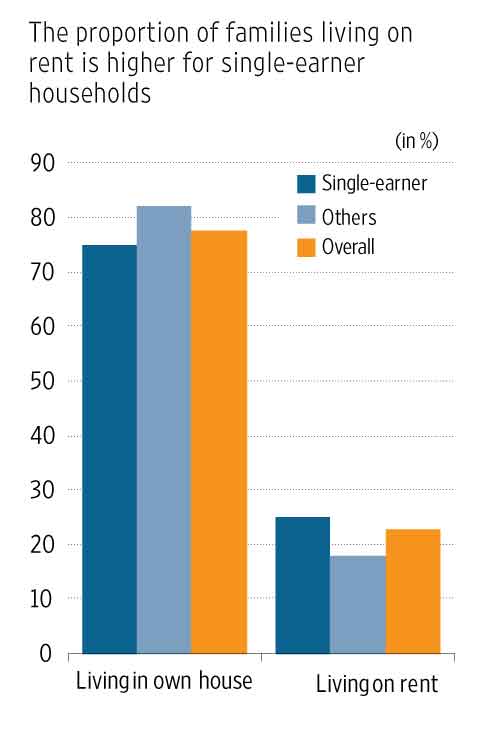Are single-earner families different from others?
Single-earner families are less likely to own a house and slightly less optimistic about the future compared to others, the ICE 360 survey shows
 Premium
Premium
New Delhi: Four out of 10 households in India have more than one earning member, according to fresh data from a large-scale nationally representative survey conducted this year. The ‘Household Survey on India’s Citizen Environment & Consumer Economy’ (ICE 360° survey) conducted this year shows that 40% households in India have multiple earners while 60% have only one earning member.
The proportion of double or multiple-earner households is higher among the poor than among the rich, the survey shows. Single-earner families dominate the richer income classes and metro-dwellers. Only a third of the households in the top quintile have more than one earning member while nearly half of the households in the bottom quintile have more than one earning member. Similarly, in metros, a little over a third of the households have more than one earning member. The proportion of such households is significantly higher in underdeveloped rural areas at 42%.
Households with more than one earning member include households where both spouses work, as well as joint families in which relatives stay together, and the household has several earning members. Given that the survey has been completed recently, the data on families with both spouses working is not available separately yet. Nonetheless, the broad trends on multiple earners seem to suggest that the female workforce participation rate in India has not changed much over the years.
ALSO READ: Indian households’ healthcare woes
The National Sample Survey Office (NSSO) report on employment in 2011-12 had shown that the proportion of working women is very low in the country. The female labour force participation rate had fallen 7 percentage points between 2004-05 and 2011-12 to 22.5%, placing India 10th from the bottom among countries ranked according to their female labour force participation rates. The high numbers of single-earner households reported in the ICE 360° survey suggests that there may not have been any big change over the past few years. However, we have to wait for detailed gender-wise break-up of the data to arrive at the exact proportion of working women in 2016.
The ICE 360° survey was conducted by the independent not-for-profit organization, People Research on India’s Consumer Economy (PRICE), headed by two of India’s best-known consumer economy experts, Rama Bijapurkar and Rajesh Shukla. The survey is among the largest consumer economy surveys in the country. The urban sample of the survey is comparable to that of the National Sample Survey Office (NSSO) consumer expenditure survey conducted in 2011-12. While the NSSO surveyed 101,651 households of which 41,968 (41.3%) were urban households, the ICE 360° survey covered 61,000 households of which 36,000 (59%) are urban households. The rural sample of the ICE 360° survey is less than half of the NSSO sample. Nonetheless, all the estimates of each region have been derived by adjusting for the respective population of those regions.
ALSO READ: India and its burden of social obligations
A notable feature of the ICE 360° survey is that it is representative at the level of economic clusters. Urban India has been divided into four clusters: metros (population more than 5 million), boom towns (2.5 to 5 million), niche cities (1 to 2.5 million) and other urban towns (less than 1 million). Based on a district development index, rural India has been sub-divided into three different clusters: ‘developed rural’, ‘emerging rural’, and ‘underdeveloped rural’. The first category includes districts such as Bathinda (Punjab) and Kangra (Himachal Pradesh). The second category includes districts such as Latur (Maharashtra) and Kamrup (Assam) while the last category includes districts such as Kalahandi (Odisha) and Bastar (Chhattisgarh).
ALSO READ: 99% Indian households are covered by a bank account
The survey shows that the proportion of single-earner families is highest in boom towns and niche cities, and it is lowest in developed rural areas. The survey also shows that households with multiple earners earn more on average compared to single-earners but the proportion of income that is saved (or invested) is similar for both groups as expenses are relatively higher for households with more earning members. The ownership of assets is also similar among single-earner households and others.
In two key respects, single-earner households differ a bit from the rest. First, they are more likely to rent a house than own one, the survey shows. And second, they are less likely to be optimistic about finances or satisfied with the stability of their earnings. They are also more likely to be worried about being able to meet the basic needs of the household with the current source of income, the survey shows.
Tadit Kundu in Mumbai contributed to this story.
This is the fourteenth of a 16-part data journalism series on how India lives, thinks, earns and spends, based on the latest results from the ICE 360° survey (www.ice360.in/) conducted by the People Research on India’s Consumer Economy (PRICE) in 2016. The next part will examine the differences between Rich India and Middle India
Unlock a world of Benefits! From insightful newsletters to real-time stock tracking, breaking news and a personalized newsfeed – it's all here, just a click away! Login Now!








